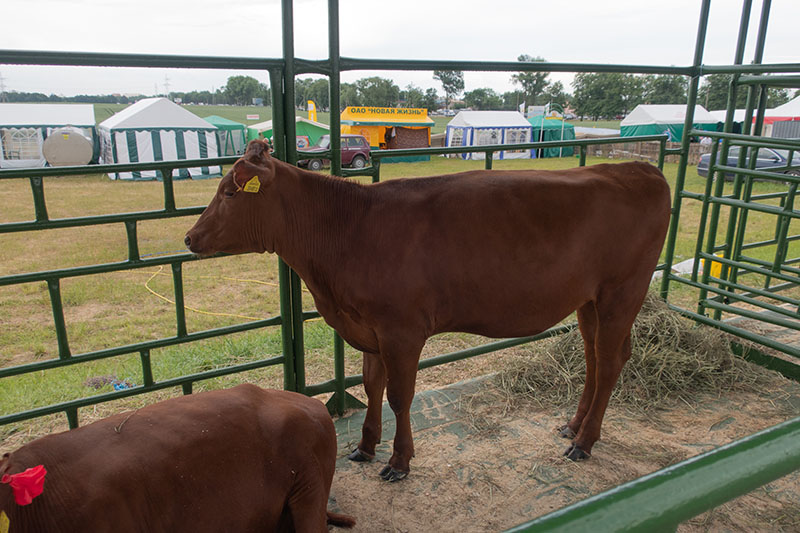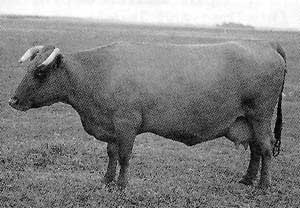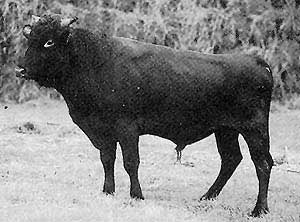Belarus Red Cattle
Also Known By: Krasnaya belorusskaya (Russian), Krasnobelorusskaya (Russian), Byelorussian Red, Red White-Russian, White-Russian Red
In the course of their history Belarus Red cattle were  repeatedly improved by infusion of the blood of the superior related red breeds. During
the last 100 years the blood of six breeds was used, Angeln and German Red at the
end of the last and early in this century, Polish Red and Danish Red in the twenties
and thirties, and Estonian Red and Latvian Brown in the fifties of this century. The
blood of Danish Red cattle is currently being introduced again.
repeatedly improved by infusion of the blood of the superior related red breeds. During
the last 100 years the blood of six breeds was used, Angeln and German Red at the
end of the last and early in this century, Polish Red and Danish Red in the twenties
and thirties, and Estonian Red and Latvian Brown in the fifties of this century. The
blood of Danish Red cattle is currently being introduced again.
A study carried out in Grodno region in 1948-49 proved that it is expedient to breed the Belarus Red inter se. They are of a single type, adapted to the local ecological, climatic and feeding conditions, and undemanding as to feed. They respond to improved feeding and management by increased milk production and high fat percentage.
The breeding of these cattle was carried out at the Vasilishkovskaya animal husbandry experiment station. In 1967 volume 1 of the National Herdbook of the Belarus Red breed was published. At present, Belarus Red cattle are found in all regions of Belarus; however, they are commonest in Grodno and Minsk regions. In 1980 they numbered 429,000.
 The appearance of the Belarus Red cows is characterized by the following features.
The head is medium long, not wide, with a long face. The poll is pronounced. The horns
are of medium size. The neck is thin and of moderate length. The withers are not sharp,
occasionally divided. The chest is of medium depth, wide enough. The back is level,
slightly narrow. The loin is long and level, of medium width. The mid-part of the
body is well developed. The abdomen is capacious, not drooping. The rump is level,
slightly raised. The hindquarters are of medium length and width, with protruding
hips. The legs are comparatively thin, bony, not long, correctly set. Sometimes legs
are splayed or bowed. The udder is medium in volume, glandular, cup-shaped or roundish.
The teats are cylindrical, of medium size. The skin is thin, elastic, mobile. The
skeleton is light and strong. The musculature is moderately developed. The conformation
is harmonious and compact; the constitution delicate.
The appearance of the Belarus Red cows is characterized by the following features.
The head is medium long, not wide, with a long face. The poll is pronounced. The horns
are of medium size. The neck is thin and of moderate length. The withers are not sharp,
occasionally divided. The chest is of medium depth, wide enough. The back is level,
slightly narrow. The loin is long and level, of medium width. The mid-part of the
body is well developed. The abdomen is capacious, not drooping. The rump is level,
slightly raised. The hindquarters are of medium length and width, with protruding
hips. The legs are comparatively thin, bony, not long, correctly set. Sometimes legs
are splayed or bowed. The udder is medium in volume, glandular, cup-shaped or roundish.
The teats are cylindrical, of medium size. The skin is thin, elastic, mobile. The
skeleton is light and strong. The musculature is moderately developed. The conformation
is harmonious and compact; the constitution delicate.
The color is red or rust-red of various shades. Many animals are noted for their longevity, while maintaining normal reproduction. Body measurements (in cm) are as follows: withers height 128.7, chest depth 68.6, oblique body length 158.3, chest girth 189.8, cannon bone girth 19.4 (National Herdbook, vol. 1, 1967). The average live weight of mature cows is 420-500 kg (maximum 530 kg); that of the bulls is 750-850 kg (950-1000 kg maximum).
 The potential of the modern Belarus Red cattle has not been completely realized. The
average milk yield of the stock evaluated at the breeding farms in 1981 was 2557 kg
with 3.69% fat; at the best farms it was 3053 kg with 3.62% fat. In the herd of Vasilishkovski
breeding center in Grodno region the average milk yield in 1982 was 2507 kg with 3.73%
fat. In recent years several groups of cows of this herd and of Shchuchin experimental
station averaged 4514 kg of milk with 4.08% fat. In her 4th lactation cow Vyetv 2016
produced 5986 kg of milk with 3.91% fat and 3.70% protein; Malta produced in her 3rd
lactation, 6056 kg of milk with 4.55% fat; Volna produced, in her 4th lactation, 5906
kg with 4.85% fat.
The potential of the modern Belarus Red cattle has not been completely realized. The
average milk yield of the stock evaluated at the breeding farms in 1981 was 2557 kg
with 3.69% fat; at the best farms it was 3053 kg with 3.62% fat. In the herd of Vasilishkovski
breeding center in Grodno region the average milk yield in 1982 was 2507 kg with 3.73%
fat. In recent years several groups of cows of this herd and of Shchuchin experimental
station averaged 4514 kg of milk with 4.08% fat. In her 4th lactation cow Vyetv 2016
produced 5986 kg of milk with 3.91% fat and 3.70% protein; Malta produced in her 3rd
lactation, 6056 kg of milk with 4.55% fat; Volna produced, in her 4th lactation, 5906
kg with 4.85% fat.
Beef and fattening qualities of Belarus Red cattle are satisfactory: under favorable conditions of feeding and management the young stock display a high growth rate and early maturity. The breed comprises 6 basic lines and 2.'D families. To preserve these cattle conservation herds have been set up and a bank of frozen semen of the best sires of all basic lines has been established. The breeding program for the improvement of Belarus Red cattle aims at the following parameters for the purebreds: the live weight of mature cows should be 500-540 kg, the milk production per lactation should be 4.5-5.0 thousand kg with fat content of 4.0-4.2% and protein content not less than 3.6%.
References
Dmitriez, N.G. and Ernst, L.K. (1989) Animal Genetic Resources of the USSR. Animal Production and Health Paper Publ. by FAO, Rome, 517 pp.
Mason, I.L. 1996. A World Dictionary of Livestock Breeds, Types and Varieties. Fourth Edition. C.A.B International. 273 pp.
